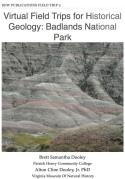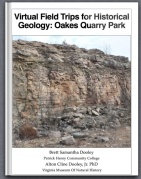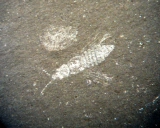 Today was the SVP bloggers lunch, where I got to meet a lot of paleontology bloggers, mostly for the first time. I already have links to many of their sites posted, and I’ll be adding more, so make sure you visit their sites–there’s a ton of great information there.
Today was the SVP bloggers lunch, where I got to meet a lot of paleontology bloggers, mostly for the first time. I already have links to many of their sites posted, and I’ll be adding more, so make sure you visit their sites–there’s a ton of great information there.
 I finally managed to make it to some dinosaur talks today. I saw several talks on ankylosaurs, including Victoria Arbour et al. on the function of tail clubs. Ankylosaurs (like Gargoyleosaurus, above, from the Denver Museum of Natural History) were covered with bony armor plates. In many species the last half or so of the tail vertebrae were locked together, and had a massive knob of bone at the end. One of these clubs (from the National Museum of Natural History) is shown below. The inverted “V”-shapes running down the middle of the bone are the interlocked neural spines of the tail vertebrae.
I finally managed to make it to some dinosaur talks today. I saw several talks on ankylosaurs, including Victoria Arbour et al. on the function of tail clubs. Ankylosaurs (like Gargoyleosaurus, above, from the Denver Museum of Natural History) were covered with bony armor plates. In many species the last half or so of the tail vertebrae were locked together, and had a massive knob of bone at the end. One of these clubs (from the National Museum of Natural History) is shown below. The inverted “V”-shapes running down the middle of the bone are the interlocked neural spines of the tail vertebrae.
 It was suggested long ago that ankylosaurs used their tail as a club to fight off predators, but this has not been universally accepted, largely because of suggestions that the heavy club would snap the ankylosaur’s tail if it tried to swing it too fast. Arbour et al. showed first that the clubs were actually not very heavy for their size, and did a stress analysis to show that the tail should easily be able to withstand the stress, and that the largest clubs could reach a velocity that would easily break bones in any target animal that was hit. It also seems that the clubs only get really large in fully mature individuals, suggesting that they may have been used more for intraspecific combat that fighting off predators (although these uses are not mutually exclusive, as anyone who has been gored by a deer can tell you).
It was suggested long ago that ankylosaurs used their tail as a club to fight off predators, but this has not been universally accepted, largely because of suggestions that the heavy club would snap the ankylosaur’s tail if it tried to swing it too fast. Arbour et al. showed first that the clubs were actually not very heavy for their size, and did a stress analysis to show that the tail should easily be able to withstand the stress, and that the largest clubs could reach a velocity that would easily break bones in any target animal that was hit. It also seems that the clubs only get really large in fully mature individuals, suggesting that they may have been used more for intraspecific combat that fighting off predators (although these uses are not mutually exclusive, as anyone who has been gored by a deer can tell you).
Cary Woodruff and David Varricchio did an interesting study in which they constructed a life-sized model of a dinosaur burrow out of PVC-pipe to try to reconstruct the depositional environment when the burrow was filled with sediment. (The burrower was Oryctodromeus, a small herbivorous dinosaur related to Hypsilophodon, below, from AMNH.)
 In the experiment, they used a modern rabbit skeleton in different states of preservation and different positions in the burrow, and then flooded the artificial burrow with a sediment-water mixture at different velocities.
In the experiment, they used a modern rabbit skeleton in different states of preservation and different positions in the burrow, and then flooded the artificial burrow with a sediment-water mixture at different velocities.
Cary Woodruff, who presented this work, spent the summers during his high-school years participating in VMNH’s excavations in Shell, WY; it’s great to see him here, four years later, presenting his own research.
There was another VMNH connection in the poster session, where Brooke Wilborn (who was digging with me at Carmel Church a few weeks ago) presented a study of the apparent difference in diversity between the Jurassic Morrison Formation and the overlying early Cretaceous rocks in the American west. Her work suggests that the Morrison, for all its famous dinosaurs, may be understudied, and that there might be a lot more dinosaurs and mammals waiting to be named from that unit.
Michael Habib proposed a rather wild hypothesis about the giant azhdarchoid pterosaurs like Quetzalcoatlus (below, from the Texas Memorial Museum).
 The idea starts by assuming these pterosaurs walked as quadrupeds (which seems to be pretty well established). This alone makes for a remarkable reconstruction, because some of these pterosaurs were so large that as a walking quadruped they would stand as tall as a giraffe. Habib then suggested that they launched themselves into the air using their front legs, rather than the back legs as birds do. In other words, their front legs (wings) were so strong compared to their body weight that they could essentially jump into the air by doing a push-up, and then flapping to gain altitude. For more discussion of this, check out Mark Witton and Darren Naish’s blog Azhdarchid Paleobiology, which is where this image came from:
The idea starts by assuming these pterosaurs walked as quadrupeds (which seems to be pretty well established). This alone makes for a remarkable reconstruction, because some of these pterosaurs were so large that as a walking quadruped they would stand as tall as a giraffe. Habib then suggested that they launched themselves into the air using their front legs, rather than the back legs as birds do. In other words, their front legs (wings) were so strong compared to their body weight that they could essentially jump into the air by doing a push-up, and then flapping to gain altitude. For more discussion of this, check out Mark Witton and Darren Naish’s blog Azhdarchid Paleobiology, which is where this image came from:











Gargoyleosaurus was discovered in 1998, so that should show that there might still be things to find in the Morrison Formation. Fruitifosser was found not too long ago. How did she arrive at the thought that one of the most prolific fossil bearing deposits in the world might be understudied? Very interesting.
I remember when that burrowing hypsolophodont was first announced in the news. So strange.That shows Montana still has a few srprises to offer.
I had read a litle bit about the pterosaurs in an issue of Smithsonian. Likened them to giraffe sized herons, stalking their prey on the ground. But the take off theory does sound very wild. I remember another National Geographic show which was on pterosaurs, talking about tracks in Europe that showed ho pterosaurs land and take off. But they were from smaller pterosaurs, nothing like the monsters above.
What Brooke shows in her Morrison work is that that Morrison only has about half as many dinosaur genera per locality as the Cretaceous units do. That situation has only developed in recent years, as the number of Cretaceous taxa has skyrocketed while the number of Morrison taxa has mostly stagnated (compared to the previous 100 years).
That suggests that either the Morrison really had a much lower diversity, it has a preservational bias (unlikely, since depositional setting is the same), or that there is a taxonomic bias caused by people working harder on the Cretaceous. She suspects that there could be new Morrison taxa that have been incorrectly shoehorned into existing species.
As she was telling me last night, since she only looked at genera in this study, it’s possible that the Morrison is richer in term of species (many Morrison genera have multiple species, while most of the Cretaceous genera only have 1 species). This could be another taxonomic bias (Morrison workers might have been loathe to erect new genera), or it could be that the Morrison has a lower disparity (fewer genera for the same number of species).
Interesting ideas. Like I said, Gargoyleosaurus was found in 1998 and a sauropod named Suuwassea was found in 2000, so perhaps we just need to keep looking.
It’s nice being the guy who looks like he’s falling asleep. 🙂
And only lunchtime, at that! But we know that you were only tired because you had gone to every single morning talk, right? 🙂
Considering Neil had the most outrageous hangover, he should have, by rights, been the one looking as though they were about to fall asleep, but he’s more vertical than Nick there!
Great to meet you Alt, even if it was only very briefly. We were almost at opposite ends of the table, but I don’t think anyone ran out of things to talk about.
Likewise. I really enjoyed the lunch (and actually being able to put faces to names!), and look forward to future events.